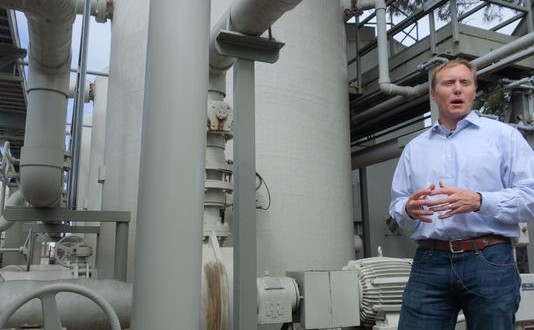With California in the grip of persistent drought, officials in the coastal city of Santa Barbara are thinking about firing up a desalination plant that has been in storage for more than two decades.
The city built the plant in the 1990s during the last drought, but activated it for only three months after heavy rains eliminated the need for extra water.
Desalination, which involves removing salt from ocean water or groundwater, is not a quick drought-relief option, but takes years of planning and overcoming red tape to launch a project.
The city estimates that it will need $20 million in technological upgrades, a cost likely to be borne by ratepayers. Any restart would require city council approval, which won’t vote until next spring after reviewing engineering plans and drought conditions.
Santa Barbara, population 89,000, has enough water for this year and even next year by buying supplemental supplies and as long as residents continue to conserve.
While it may seem like a head-scratcher to put the plant in hibernation soon after it was built, officials said the decision saved the city millions of dollars in unnecessary operating costs.
“With the current drought likely to continue, they now appear as if they will be able to cash in on their insurance policy,” said Tom Pankratz, editor of Water Desalination Report and consultant on several other desalination projects in California.
The cyclical nature of droughts has made it difficult, if not impossible, to bet on desalination. It requires prime coastal real estate and the foresight to diversify the water supply in flush and dry times. Communities that choose desalination may be more resilient to inevitable droughts in the future.
Santa Barbara relies on water piped through tunnels from the Santa Ynez Mountains. But with Lake Cachuma, the main reservoir, dangerously low, the city expects desalination to play a role.
“We live in a desert. We can expect droughts. It’s just inevitable that desalination is going to become a part of our regular water portfolio,” Haggmark said.
Santa Barbara is not alone in mulling desalination as parched conditions persist for a third straight year, forcing some rural places to ration water and farmers to fallow fields.
Earlier this year, the agency that delivers water to the central coast town of Cambria voted to approve an emergency desalination plant with the hopes of getting it running by July before water supplies dry up.
Instead of drawing ocean water, the proposed $5-million plant would pull brackish water from a well, treat it and reinject it into the aquifer. Since that would require a lengthy study, the plant likely won’t be able to go online until fall.
Not long ago, there was a rush to quench California’s growing thirst with seaside desalination plants. Currently, there are about a dozen proposed projects, according to the California Coastal Commission, which is charged with permitting the facilities.
The Western Hemisphere’s largest desalination plant is under construction north of San Diego after overcoming years of regulatory hurdles. The developer — Poseidon Resources LLC — is seeking approval to build another one in Huntington Beach, south of Los Angeles.
In California’s agricultural belt, a solar-powered desalination plant in Fresno County has purified irrigation runoff for the past year. The output is small, but the operator hopes to expand.
Not every community embraces desalination. The port city of Long Beach is trying to reduce dependence on imported water but dropped the idea of desalination after realizing the cost.
Australia, Singapore, Israel, Saudi Arabia and other thirsty countries are big desalination supporters, but tougher regulatory requirements have made it a harder sell in the U.S.
Many environmentalists see desalination as a last resort, contending it’s an energy hog that sucks marine life into the plants.
Other options should be exhausted “before you start putting a straw into the ocean,” said Susan Jordan, executive director of the California Coastal Protection Network based in Santa Barbara. “People tend to have a knee-jerk reaction to drought.”
The city council is set to take action Tuesday on an $820,000 contract spelling out what’s needed to restart the facility. The city contends that it has the permits to reactivate the plant, but the state coastal commission said it needs new or amended permits.
On a recent tour of the ghost plant, Haggmark inspected the onetime state-of-the-art control room. A pair of bulky desktop computers boasting floppy disk drives served as a vintage reminder. A line of trailers outside store the original pumps and empty metal cylinders that used to hold parts that have since been sold. Intake valves pulled from the seafloor sit exposed to the elements.
The original plant had a capacity to produce about 7,500 acre-feet of water per year, about half of the city’s average water use. An acre foot is enough to last a family of four about a year.
Haggmark acknowledged desalination’s limits, but he said it made sense to start considering it as an option to ease the strain on local supplies. The earliest restart date would be summer 2016.
“This community can’t conserve its way out of this drought as it currently has been unfolding,” he said. “It’s just been unprecedentedly dry.”
Agencies/AP/Canadajournal

 Canada Journal – News of the World Articles and videos to bring you the biggest Canadian news stories from across the country every day
Canada Journal – News of the World Articles and videos to bring you the biggest Canadian news stories from across the country every day

